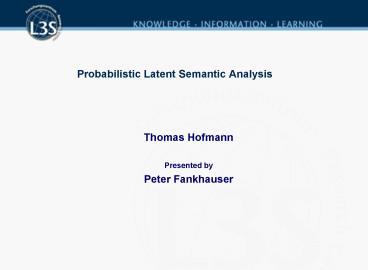Probabilistic Latent Semantic Analysis - PowerPoint PPT Presentation
1 / 18
Title:
Probabilistic Latent Semantic Analysis
Description:
Evaluation: Perplexity Comparison. Perplexity Log-averaged inverse ... High probability will give lower perplexity, thus good predictions. MED data. 10/5/09 ... – PowerPoint PPT presentation
Number of Views:241
Avg rating:3.0/5.0
Title: Probabilistic Latent Semantic Analysis
1
Probabilistic Latent Semantic Analysis
- Thomas Hofmann
- Presented by
- Peter Fankhauser
2
Probabilistic Latent Semantic Analysis
- Automated Document Indexing and Information
retrieval
Identification of Latent Classes (Aspects) using
an Expectation Maximization (EM) Algorithm
- Shown to solve
- Polysemy
- Java could mean coffee and also the PL Java
- Cricket is a game and also an insect
- Synonymy
- computer, pc, desktop all could mean the
same
- Has a better statistical foundation than LSA
3
Aspect Model
- Latent Variable model for general co-occurrence
data - Associate each observation (w,d)with a class
variable z ? Zz_1,,z_K
- Generative Model
- Select a doc with probability P(d)
- Pick a latent class z with probability P(zd)
- Generate a word w with probability P(wz)
P(d)
P(zd)
P(wz)
d
z
w
4
PLSA Aspect Model
- Aspect Model
- Document is a mixture of underlying (latent) K
aspects - Each aspect is represented by a distribution of
words P(wz) - Model fitting with Tempered EM
5
Aspect Model
- The joint distribution P(d,w) is the sum over all
aspects z - Assuming conditional independence of d and w
given z.
6
Advantages of this model over Document Clustering
- Documents are not related to a single cluster
(i.e. aspect ) - For each z, P(dz) defines a specific mixture of
factors - This offers more flexibility, and produces
effective modeling - Problem Estimate P(z), P(dz), P(wz). We are
given just documents(d) and words(w). - Approach Expectation Maximization (EM)
7
EM Steps
- E-Step
- Expectation step where expectation of the
likelihood function is calculated with the
current parameter values - M-Step
- Update the parameters with the calculated
posterior probabilities - Find the parameters that maximizes the likelihood
function
8
E Step
- Probability of aspect zgiven that a word w
occurs in a document d
9
M Step
- All these equations use P(zd,w) calculated in E
Step
10
Tempered EM
- Trade off between Predictive performance on the
training data and Unseen new data - Must prevent the model to over fit the training
data - Introduce damp factor ß into E-step
11
Evaluation Perplexity Comparison
- Perplexity Log-averaged inverse probability on
unseen data - High probability will give lower perplexity, thus
good predictions - MED data
12
Evaluation Topic Decomposition
- Abstracts of 1568 documents
- Clustering 128 latent classes
- Shows word stems for
- the same word power
- as p(wz)
- Power1 Astronomy
- Power2 - Electricals
13
Evaluation Polysemy
- Segment occurring in two different contexts are
identified (image, sound)
14
Evaluation Information Retrieval
- MED 1033 docs
- CRAN 1400 docs
- CACM 3204 docs
- CISI 1460 docs
- Reporting only the best results with K varying
from 32, 48, 64, 80, 128 - PLSI model takes the average across all models
at different K values
15
Evaluation Information Retrieval
- Cosine Similarity is the baseline
- In LSI, query vector(q) is multiplied to get the
reduced space vector - In PLSI, p(zd) and p(zq). In EM iterations,
only P(zq) is adapted
16
Evaluation Precision-Recall results
17
Comparing PLSA and LSA
- LSA and PLSA perform dimensionality reduction
- In LSA, by keeping only K singular values
- In PLSA, by having K aspects
- Comparison to SVD
- U Matrix related to P(dz) (doc to aspect)
- V Matrix related to P(zw) (aspect to term)
- E Matrix related to P(z) (aspect strength)
- The main difference is the way the approximation
is done - PLSA generates a model (aspect model) and
maximizes its predictive power - Selecting the proper value of K is heuristic in
LSA - Model selection in statistics can determine
optimal K in PLSA
18
Conclusion
- PLSI consistently outperforms LSI in the
experiments - Precision gain is 100 compared to baseline
method in some cases - PLSA has statistical theory to support it, and
thus better than LSA. - .
- Enter Probabilistic Topic Models, Mark Steyvers,
Tom Griffiths (In T. Landauer, D. McNamara, S.
Dennis, and W. Kintsch (eds), Latent Semantic
Analysis A Road to Meaning. Laurence Erlbaum.































